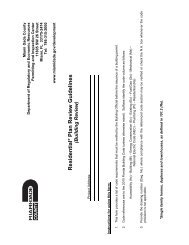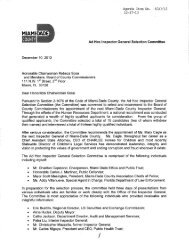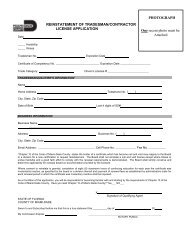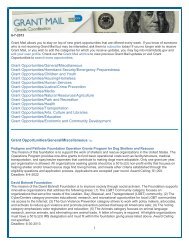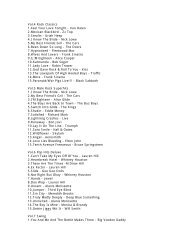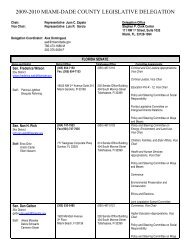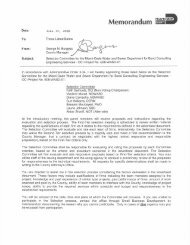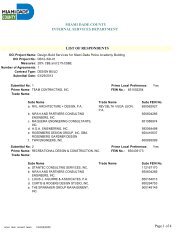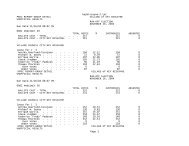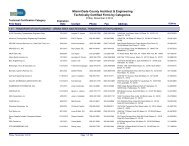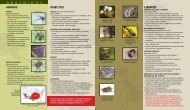- Page 1 and 2:
Environmental Management System Man
- Page 4 and 5:
FIGURES Figure 1 Facility Location
- Page 6 and 7:
2. FACILITY DESCPRIPTION The Miami-
- Page 8 and 9:
The MDT Metro Mover Facility (MMF)
- Page 10 and 11:
3. ENVIRONMENTAL MANAGEMENT SYSTEM
- Page 12 and 13:
3.2 EMS Documents An EMS is based o
- Page 14 and 15:
4.3 Planning 4.3.1. Environmental a
- Page 16 and 17:
authorities are defined, documented
- Page 18 and 19:
Refer to Attachment H for a copy of
- Page 20 and 21:
4.5 Checking 4.5.1. Monitoring and
- Page 22 and 23:
Refer to Attachment O for a copy of
- Page 24:
Figures
- Page 28:
Attachment A Environmental Policy a
- Page 31 and 32:
Miami-Dade Transit Verification Ori
- Page 33 and 34:
Miami-Dade Transit Verification Ori
- Page 35 and 36:
Miami-Dade Transit Verification Ori
- Page 37 and 38:
Miami-Dade Transit Verification Ori
- Page 39 and 40:
Miami-Dade Transit Verification Ori
- Page 41 and 42:
Organization Name: Miami-Dade Trans
- Page 43 and 44:
Aspect Identifier Activity/Product/
- Page 45 and 46:
Aspect Identifier A9 A10 A11 A12 A1
- Page 47 and 48:
Miami-Dade Transit Verification Ori
- Page 49 and 50:
Attachment C Legal and Other Requir
- Page 51 and 52:
Miami-Dade Transit Metromover Maint
- Page 53 and 54:
Miami-Dade Transit Metromover Maint
- Page 55 and 56:
Miami-Dade Transit Person Responsib
- Page 57 and 58:
Attachment D Objectives, Targets, a
- Page 59 and 60:
Miami-Dade Transit Verification Ori
- Page 61 and 62:
Miami-Dade Transit Verification Ori
- Page 63 and 64:
Miami-Dade Transit Person resp Prep
- Page 65 and 66:
Miami-Dade Transit Person resp Prep
- Page 67 and 68:
Miami-Dade Transit Person resp Prep
- Page 69 and 70:
Miami-Dade Transit Person resp Prep
- Page 71 and 72:
Miami Dade Transit Verification Ori
- Page 73 and 74:
Miami Dade Transit Verification Ori
- Page 75 and 76:
Miami-Dade Transit Prepared by Revi
- Page 77 and 78:
Attachment F Competence, Training,
- Page 79 and 80:
Miami-Dade Transit Verification Ori
- Page 81 and 82:
Miami-Dade Transit Verification Ori
- Page 83 and 84:
1 Miami-Dade Transit Verification O
- Page 85 and 86:
17 Miami-Dade Transit Verification
- Page 87 and 88:
Miami-Dade Transit Verification Ori
- Page 89 and 90:
Miami-Dade Transit Verification Ori
- Page 91 and 92:
Miami-Dade Transit Verification Ori
- Page 93 and 94:
Benefits of an EMS An EMS provides
- Page 95 and 96:
Miami-Dade Transit Verification Ori
- Page 97 and 98:
Miami-Dade Transit Verification Ori
- Page 99 and 100:
Miami-Dade Transit Verification Ori
- Page 101 and 102:
Miami-Dade Transit Verification Ori
- Page 103 and 104:
Miami-Dade Transit Verification Ori
- Page 105 and 106:
Miami-Dade Transit Verification Ori
- Page 107 and 108:
Miami-Dade Transit Verification Ori
- Page 109 and 110:
Miami Dade Transit Verification Ori
- Page 111 and 112:
Miami Dade Transit Verification Ori
- Page 113 and 114:
Miami Dade Transit Verification Ori
- Page 115 and 116:
MIAMI-DADE TRANSIT Environmental Ma
- Page 117 and 118:
1 Miami Dade Transit Verification O
- Page 119 and 120:
Miami Dade Transit Verification Ori
- Page 121 and 122:
Miami Dade Transit Verification Ori
- Page 123 and 124:
Miami Dade Transit Verification Ori
- Page 125 and 126:
Miami Dade Transit Verification Ori
- Page 127 and 128:
Miami-Dade Transit Verification Ori
- Page 129 and 130: Miami-Dade Transit Verification Ori
- Page 131 and 132: Miami-Dade Transit Verification Ori
- Page 133 and 134: Miami-Dade Transit MDT Internal Doc
- Page 135 and 136: Miami-Dade Transit MDT Internal Doc
- Page 137 and 138: Miami-Dade Transit MDT Internal Doc
- Page 139 and 140: Miami-Dade Transit MDT Internal Doc
- Page 141 and 142: Miami-Dade Transit MDT Internal Doc
- Page 143 and 144: Miami-Dade Transit MDT Internal Doc
- Page 145 and 146: Miami-Dade Transit MDT Internal Doc
- Page 147 and 148: Miami-Dade Transit MDT Internal Doc
- Page 149 and 150: Miami-Dade Transit MDT Internal Doc
- Page 151 and 152: Miami-Dade Transit Verification Ori
- Page 153 and 154: Miami-Dade Transit Verification Ori
- Page 155 and 156: Miami-Dade Transit Verification Ori
- Page 157 and 158: Miami-Dade Transit Verification Ori
- Page 159 and 160: Miami-Dade Transit Verification Ori
- Page 161 and 162: Miami-Dade Transit Verification Ori
- Page 163 and 164: Miami-Dade Transit Verification Ori
- Page 165 and 166: Miami-Dade Transit Verification Ori
- Page 167 and 168: Miami-Dade Transit Verification Ori
- Page 169 and 170: Miami-Dade Transit Verification Ori
- Page 171 and 172: Miami-Dade Transit Verification Ori
- Page 173 and 174: Attachment K Emergency Preparedness
- Page 175 and 176: Miami-Dade Transit Verification Ori
- Page 177 and 178: Miami-Dade Transit Verification Ori
- Page 179: Miami-Dade Transit Verification Ori
- Page 183 and 184: III. Inspections and Maintenance MD
- Page 185 and 186: • The discharged material enters
- Page 187 and 188: STORAGE TANK SYSTEM ANNUAL INSPECTI
- Page 189 and 190: I. Loading dock A. Tank 1: 200-gall
- Page 191 and 192: Attachment L Monitoring and Measure
- Page 193 and 194: Miami-Dade Transit Verification Ori
- Page 195 and 196: Miami-Dade Transit Verification Ori
- Page 197 and 198: Miami-Dade Transit Verification Ori
- Page 199 and 200: Miami-Dade Transit Verification Ori
- Page 201 and 202: Miami-Dade Transit Verification Ori
- Page 203 and 204: Miami-Dade Transit Verification Ori
- Page 205 and 206: Miami-Dade Transit Verification Ori
- Page 207 and 208: Attachment M Evaluation of Complian
- Page 209 and 210: Miami-Dade Transit Person Resp. Pre
- Page 211 and 212: Miami-Dade Transit Person Resp. Pre
- Page 213 and 214: Miami-Dade Transit Work Product for
- Page 215 and 216: Miami-Dade Transit Work Product for
- Page 217 and 218: Miami-Dade Transit Work Product for
- Page 219 and 220: Miami-Dade Transit Work Product for
- Page 221 and 222: Miami-Dade Transit Work Product for
- Page 223 and 224: Miami-Dade Transit Person Resp. Pre
- Page 225 and 226: Miami-Dade Transit Person Resp. Pre
- Page 227 and 228: Attachment N Nonconformity, Correct
- Page 229 and 230: Miami-Dade Transit Person resp Prep
- Page 231 and 232:
Miami-Dade Transit Person resp Prep
- Page 233 and 234:
Miami-Dade Transit Person Resp. Pre
- Page 235 and 236:
Attachment O Control of Records Pro
- Page 237 and 238:
Miami-Dade Transit Person Resp. Pre
- Page 239 and 240:
Miami-Dade Transit Person Resp. Pre
- Page 241 and 242:
Miami-Dade Transit Person Resp. Pre
- Page 243 and 244:
Miami-Dade Transit Person Resp. Pre
- Page 245 and 246:
Miami-Dade Transit Person Resp. Pre
- Page 247 and 248:
Miami-Dade Transit Person Resp. Pre
- Page 249 and 250:
Miami-Dade Transit Person Resp. Pre
- Page 251 and 252:
Miami-Dade Transit Person Resp. Pre
- Page 253 and 254:
Miami-Dade Transit EMS Internal Aud
- Page 255 and 256:
Miami-Dade Transit EMS Internal Aud
- Page 257 and 258:
Miami-Dade Transit EMS Internal Aud
- Page 259 and 260:
Miami-Dade Transit EMS Internal Aud
- Page 261 and 262:
Miami-Dade Transit EMS Internal Aud
- Page 263 and 264:
Miami-Dade Transit EMS Internal Aud
- Page 265 and 266:
Miami-Dade Transit Verification Ori
- Page 267 and 268:
Miami-Dade Transit Verification Ori
- Page 269 and 270:
Miami-Dade Transit Verification Ori
- Page 271 and 272:
Miami-Dade Transit Verification Ori
- Page 273 and 274:
Miami-Dade Transit Verification Ori
- Page 275 and 276:
Metro Mover Facility ISO 14001 Cert



